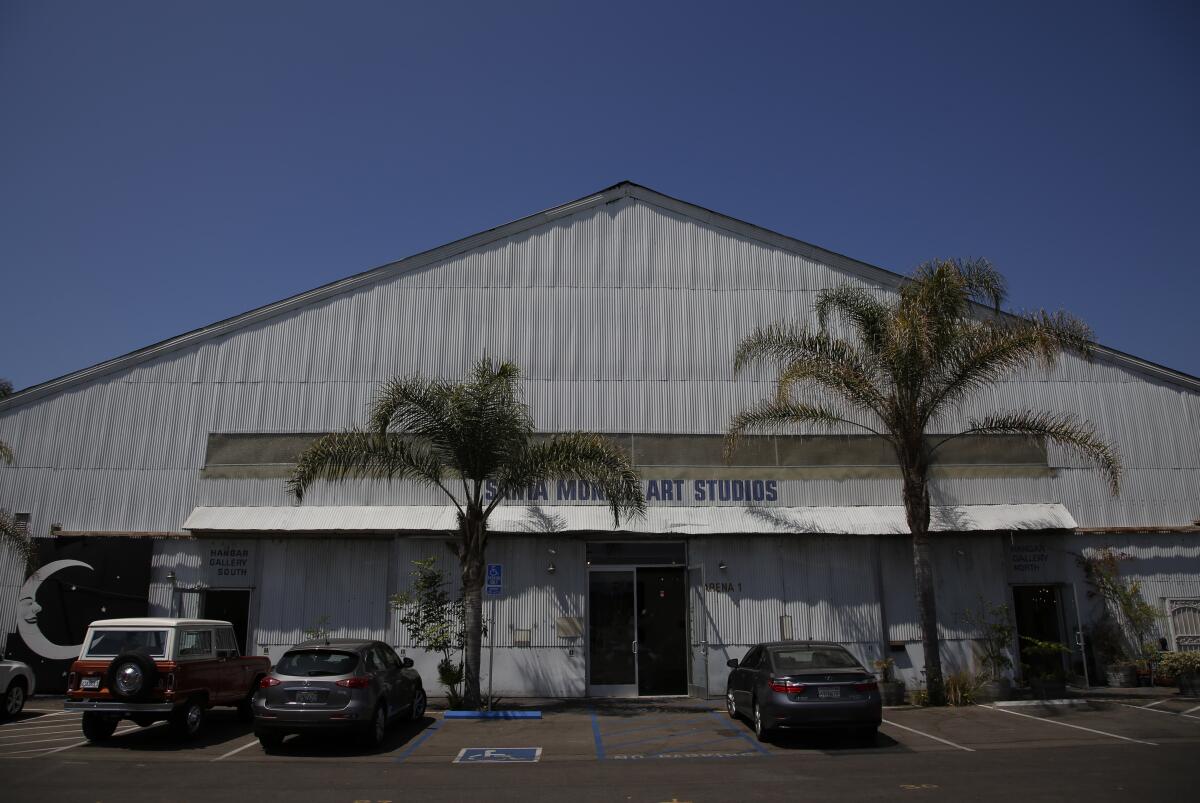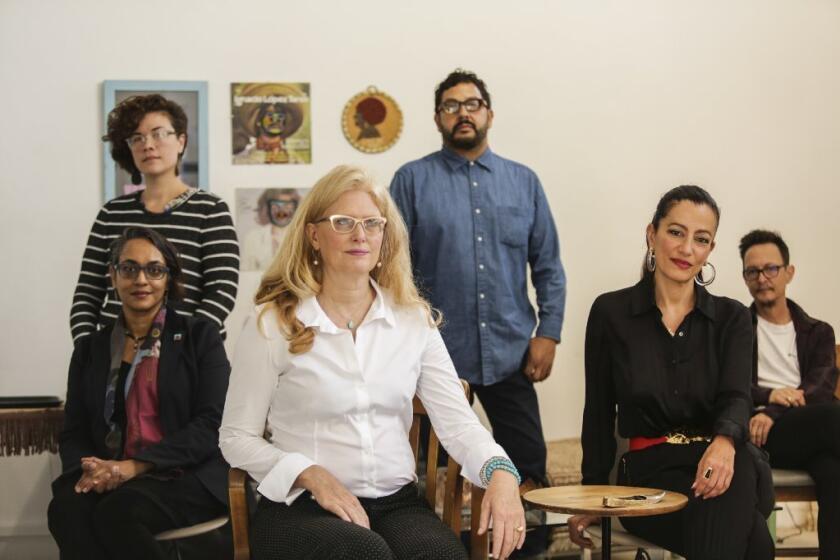18th Street Arts Center debuts Santa Monica Airport space with sleep machines. Here’s why
- Share via
Step into one of the old hangars at the Santa Monica Airport at the end of this month and you may stumble into a cluster of 20 people playing the soothing sounds of sleep machines. This will not be a hallucinatory dream induced by a visit to Best Buy. It will be a performance by composer Guillermo Galindo and the art collective Postcommodity (artists Cristóbal Martínez and Kade L. Twist), which will fill the industrial architecture with reverberations of falling rain and chirping birds.
The piece, says Twist, will be about “learning how to listen ... listening across difference and listening in a deep way.”
The performance, to take place July 31, also marks the debut of the 18th Street Arts Center’s new lineup of exhibitions and programming in a converted hangar at the Santa Monica Airport.
The three-decade-old center, which occupies a compound of light industrial buildings on 18th Street in Santa Monica, about two miles north of the airport, is known for providing residency and studio space to local and visiting artists, and has long served as an important site in which to develop work and conduct research. But its current on-site exhibition spaces are limited. The new site at the airport adds a gallery and a space from which to engage the surrounding community.
“We want to expand to the public in a more accessible way,” says artistic director Anuradha Vikram.
Santa Monica’s 18th Street Arts Center marks 30 years of avant-garde art.
The airport site, which sits across the street from Barker Hangar on Airport Avenue, was, until last month, known as as the Santa Monica Art Studios (which included a gallery space called Arena1). The studios had occupied the building since the early 2000s, when founders Yossi Govrin and Sherry Frumkin took over the dilapidated hangar and turned it into a workspace for artists. The Santa Monica Art Studios held the master lease on the space; artists, in turn, sublet their studios from them.
In 2016, however, the City of Santa Monica, as part of its plan to phase out the airport, passed a law that prohibited subletting — a way of giving the city greater control over who leases space at the site. As part of the plan, the artists who occupied studios at the hangar were allowed to remain, but they now pay their rent directly to the city.
To manage the day-to-day needs of the property, the Santa Monica City Council last year solicited requests for proposals, then announced in December that it would enlist the services of the 18th Street Arts Center. The center took over management of the studios on July 1. They have a two-year contract with three one-year options to renew.
To kick off its stewardship of the studios, 18th Street enlisted Galindo and Postcommodity, the former a well-known experimental composer known for fabricating his own instruments, the latter a long-running collective that is this week unveiling a new installation at the Art Institute of Chicago. The artists came together as part of a month-long residency at 18th Street — Galindo and Martínez live in the Bay Area and Twist is based in Los Angeles — that allowed them to develop the work that they will present at the hangar.
“The hangar is 20,000 square feet and it’s open,” says Vikram. “They want to turn the space into a resonator. It won’t be super loud, but really soothing and compassionate.”
For the piece, which will be preceded by an indigenous land acknowledgment led by Tongva elders, they have enlisted the participation of 20 individuals who work in the community — “people working in affordable housing or social services delivery,” Twist says. And they have armed them with sleep machines that they will play in response to and in harmony with each other, but also in reaction to the loops of sound that the artists will feed back into the space. (Something vaguely akin to chanting, in which a person must adjust their tone to the people around them, while also adjusting to the sound produced by the whole.)
“Part of the choreography is stopping, listening, evaluating and reasserting a sound,” Twist says. “It’s having [the act of] listening be the driver of the composition, the mover of the people in space — like Pauline Oliveros or John Cage or those traditions.”
Beyond filling the hangar with sound, the piece also aims to bring together people in Santa Monica who have shared goals, if not always shared aims for how to achieve them — something that is important to Twist, who teaches art and social practice at the Otis School of Art and Design.
“I don’t like to use the word, but I teach it — but it’s to look at a particular social practice methodology and align it with Guillermo Galindo’s radical compositions,” says Twist. “It’s not really a mediation process but a facilitation process, so that people can learn to abstractly represent then harmonize their mission.”
But why sleep machines?
It’s all about the metaphor, Twist explains. “We live in this new age of self-love and self-care and all that crap,” he says. “We want to just take that and run with it — not making people drown in it, but let’s actually use them to calm ourselves down.”

The 18th Street Arts Center presents: Postcommodity and Guillermo Galindo
More to Read
The biggest entertainment stories
Get our big stories about Hollywood, film, television, music, arts, culture and more right in your inbox as soon as they publish.
You may occasionally receive promotional content from the Los Angeles Times.












